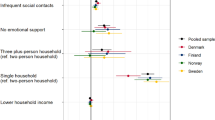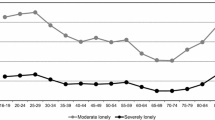Abstract
This study explores country differences in late-life loneliness in Europe among men and women and establishes the role of micro-level differences in socioeconomic status, health, and social variables in these patterns. We use cross-sectional, nationally representative data from the Generations and Gender Survey. The analysis comprises 33,832 Europeans aged 60–80 from 11 countries. A six-item short version of the de Jong-Gierveld Scale is used to measure loneliness, yet we employ a different method of calculating loneliness scores than in prior work. Findings show considerable between-country heterogeneity in late-life loneliness, especially among women. The rate of a quite severe level of loneliness is 30–55 % among men and women in Eastern Europe, compared with 10–20 % among their peers in Western and Northern Europe. Loneliness is strongly associated with lower socioeconomic status, poorer health, and not having a partner. More than half of the country variance in loneliness is mediated by health, partnership status, and socioeconomic disparities across countries. Differences in societal wealth and welfare and cultural norms may account for some of the unexplained country variance in loneliness.


Similar content being viewed by others
References
Abramson, A., & Silverstein, M. (2006). Images of aging in America 2004. Washington: AARP and the University of Southern California.
Bishop, A. J. (2007). The indirect influence of educational attainment on loneliness among unmarried older adults. Educational Gerontology, 33(10), 897–917.
Botev, N. (2012). Population ageing in Central and Eastern Europe and its demographic and social context. European Journal of Ageing, 9(1), 69–79.
de Jong-Gierveld, J. (2006). Societal trends and lifecourse events affecting diversity in later life. In S. O. Daatland & S. Biggs (Eds.), Ageing and diversity: multiple pathways and cultural migrations (pp. 175–188). Bristol: Policy Press.
de Jong-Gierveld, J., Dykstra, P. A., & Schenk, N. (2012). Living arrangements, intergenerational support types and older adult loneliness in Eastern and Western Europe. Demographic Research, 27, 167–199.
de Jong-Gierveld, J., & Tesch-Romer, C. (2012). Loneliness in old age in Eastern and Western European societies: Theoretical perspectives. European Journal of Ageing, 9(4), 285–295.
de Jong-Gierveld, J., & van Tilburg, T. (1999). Manual of the loneliness scale. Amsterdam: Vrije Universiteit.
de Jong-Gierveld, J., & van Tilburg, T. (2010). The de Jong-Gierveld short scales for emotional and social loneliness: Tested on data from 7 countries in the UN generations and gender survey. European Journal of Ageing, 7, 121–130.
de Jong-Gierveld, J., van Tilburg, T., & Dykstra, P. A. (2006). Loneliness and social isolation. In A. Vangelisti & D. Perlman (Eds.), Cambridge handbook of personal relationships (pp. 285–500). Cambridge: University Press.
Deaton, A. (2007). Income, aging, health and wellbeing around the world: Evidence from the Gallup World Poll. Journal of Economic Perspectives, 22(2), 53–72.
Dykstra, P. A. (2009). Older adult loneliness: Myths and realities. European Journal of Ageing, 6(2), 91–100.
Ferrer-i-Carbonell, A., & Frijters, P. (2004). How important is methodology for the estimates of the determinants of happiness? Economic Journal, 114, 641–659.
Fokkema, T., de Jong-Gierveld, J., & Dykstra, P. A. (2012). Cross-national differences in older adult loneliness. Journal of Psychology, 146, 201–228.
Fokkema, T., Kveder, A., & Liefbroer, A. (2014). Report and recommentations for sample and data adjustment procedures. GGP (deliverable).
Goodwin, R. (2006). Age and social support perception in Eastern Europe: Social change and support in four rapidly changing countries. British Journal of Social Psychology, 45, 799–815.
Hansen, T. (2010). Subjective well-being in the second half of life: The influence of family and household resources. Dissertation. University of Oslo, Faculty of Medicine.
Hawkley, L. C., & Cacioppo, J. T. (2007). Aging and loneliness: Downhill quickly? Current Directions in Psychological Science, 16(4), 187–191.
Hawkley, L. C., Hughes, M. E., Waite, L. J., Masi, C. M., Thisted, R. A., & Cacioppo, J. T. (2008). From social structural factors to perceptions of relationship quality and loneliness: The Chicago Health, Aging, and Social Relations Study. Journals of Gerontology Series B-Psychological Sciences and Social Sciences, 63(6), 375–384.
Hvinden, B. (2010). The Nordic welfare model and the challenge of globalisation. In M. Böss (Ed.), The nation state in transformation: Economic globalisation, institutional mediation and political values (pp. 292–314). Århus: University Press.
Iecovich, E., Barasch, M., Mirsky, J., Kaufman, R., Avgar, A., & Kol-Fogelson, A. (2004). Social support networks and loneliness among elderly Jews in Russia and Ukraine. Journal of Marriage and Family, 66(2), 306–317.
Johnson, D., & Mullins, L. (1987). Growing old and lonely in different societies: Toward a comparative perspective. Journal of Cross-Cultural Gerontology, 2(3), 257.
Jylha, M., & Jokela, M. (1990). Individual experiences as cultural: A cross-cultural study on loneliness among the elderly. Ageing and Society, 10, 295–315.
Lasgaard, M. (2007). Reliability and validity of the Danish version of the UCLA Loneliness Scale. Personality and Individual Differences, 7, 1359–1366.
Lipsitz, L. A. (2005). The elderly people of post-soviet Ukraine: Medical, social, and economic challenges. Journal of the American Geriatrics Society, 53(12), 2216–2220.
Mirowsky, J., & Ross, C. E. (2007). Life course trajectories of perceived control and their relationship to education. American Journal of Sociology, 112(5), 1339–1382.
Nicolaisen, M., & Thorsen, K. (2014). Who are lonely? Loneliness in different age groups (18–81 years old), using two measures of loneliness. International Journal of Aging and Human Development, 78, 229–257.
OECD. (2012a). International migration outlook 2014. OECD Publishing.
OECD. (2012b). Education at a glance 2012: OECD indicators. OECD Publishing.
Petrov, I. C. (2007). The elderly in a period of transition: Health, personality, and social aspects of adaptation. Healthy Aging and Longevity, 1114, 300–309.
Pew Research. (2009). Two decades after the wall’s fall: End of communism cheered but now with more reservations. Washington, DC: Pew Research Center.
Pietilä, I., & Rytkönen, M. (2008). Coping with stress and by stress: Russian men and women talking about transition, stress and health. Social Science & Medicine, 66, 327–338.
Pinquart, M., & Sörensen, S. (2001). Influences on loneliness in older adults: A meta-analysis. Basic and Applied Social Psychology, 23(4), 245–266.
Ploubidis, G. B., & Grundy, E. (2009). Later-life mental health in Europe: A country-level comparison. Journals of Gerontology Series B-Psychological Sciences and Social Sciences, 64(5), 666–676.
Reher, D. S. (1998). Family ties in western Europe: Persistent contrasts. Population and Development Review, 24(2), 203–234.
Rokach, A. (2007). The effect of age and culture on the causes of loneliness. Social Behavior and Personality, 35(2), 169–186.
Rokach, A., Orzeck, T., Cripps, J., Lackovic-Grgin, K., & Penezic, Z. (2001). The effects of culture on the meaning of loneliness. Social Indicators Research, 53(1), 17–31.
Saltkjel, T., Dahl, E., & van der Wel, K. A. (2013). Health related social exclusion in Europe: A multilevel study of the role of welfare generosity. International Journal for Equity in Health, 12, 81–92.
Saraceno, C., & Keck, W. (2010). Can we identify intergenerational policy regimes in Europe? European Societies, 12(5), 675–696.
Sundstrom, G., Fransson, E., Malmberg, B., & Davey, A. (2009). Loneliness among older Europeans. European Journal of Ageing, 6(4), 267–275.
Tornstam, L. (2007). Stereotypes of old people persist. A Swedish, “Facts on aging quiz” in a 23-year comparative perspective. International Journal of Ageing and Later Life, 2(1), 33–59.
van Oorschot, W., & Arts, W. (2005). The social capital of European welfare states: The crowding out hypothesis revisited. Journal of European Social Policy, 15(1), 5–26.
van Tilburg, T., & De Leeuw, E. (1991). Stability of scale quality under various data collection procedures: a mode comparison of the "De Jong-Gierveld Loneliness Scale". International Journal of Public Opinion Research, 3, 69–85.
Viazzo, P. (2010). Family, kinship and welfare provision in Europe, past and present: Commonalities and divergences. Continuity and Change, 25(1), 137–159.
Victor, C., Bond, J., & Scambler, S. (2009). The social world of older people. Maidenhead: Open University Press.
Victor, C., Scambler, S., Bond, J., & Bowling, A. (2000). Being alone in later life: Loneliness, social isolation and living alone. Reviews in Clinical Gerontology, 10, 407–417.
Weiss, R. S. (1973). Loneliness: The experience of emotional and social isolation. Cambridge, MA: MIT Press.
Yang, K. M., & Victor, C. (2011). Age and loneliness in 25 European nations. Ageing and Society, 31, 1368–1388.
Acknowledgments
This research was supported by a grant from the Research Council of Norway (Grant No. 228664). The NorLAG and LOGG surveys are financed by the Research Council of Norway (Grant Nos. 149564 and 168373), Ministry of Health and Care Services, Ministry of Labour, Ministry of Children, Equality and Social Inclusion, Ministry of Local Government and Regional Development, NOVA and Statistics Norway. The LOGG and NorLAG datasets are part of the ACCESS Life Course infrastructure project funded by the National Financing Initiative for Research Infrastructure at the Research Council of Norway (Grant No. 195403) and NOVA.
Author information
Authors and Affiliations
Corresponding author
Rights and permissions
About this article
Cite this article
Hansen, T., Slagsvold, B. Late-Life Loneliness in 11 European Countries: Results from the Generations and Gender Survey. Soc Indic Res 129, 445–464 (2016). https://doi.org/10.1007/s11205-015-1111-6
Accepted:
Published:
Issue Date:
DOI: https://doi.org/10.1007/s11205-015-1111-6




